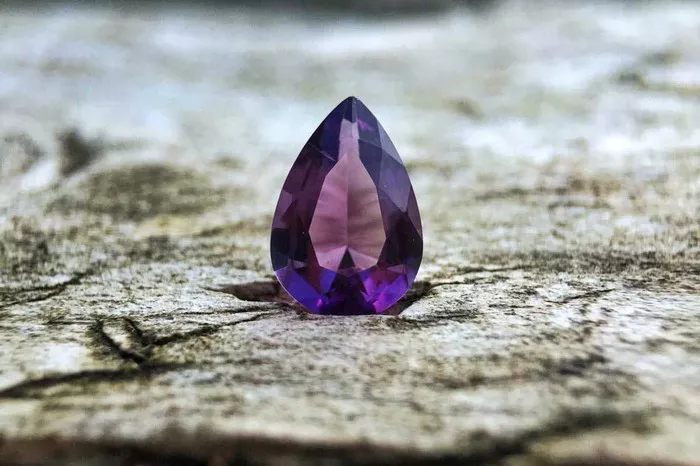Amethysts are among the most captivating gemstones, cherished for their vibrant purple hues and spiritual significance. But have you ever come across a red amethyst? This rare and striking variation is a fascinating blend of geology, chemistry, and natural artistry. In this article, we’ll uncover how red amethyst is made, the science behind its formation, and its significance in the gemstone world.
What Is Red Amethyst?
Red amethyst, also known as “hematite-included amethyst,” is a unique variety of the traditional purple amethyst. It features an infusion of reddish tones, creating a spectacular gemstone that appears to blend shades of purple, red, and pink. This striking coloration results from specific geological conditions that occur during the stone’s formation.
Unlike standard amethyst, the red hue comes from the presence of hematite, a mineral form of iron oxide, either coating the crystal or included within it. The resulting color spectrum makes red amethyst a prized specimen for collectors, jewelers, and spiritual enthusiasts alike.
Where Does Red Amethyst Come From?
The primary sources of red amethyst are Brazil and certain regions in Africa, particularly Madagascar. These locations provide the ideal geological conditions for the formation of amethyst crystals, as well as the presence of hematite.
The red coloration is more common in geodes and clusters rather than in single, isolated crystals. These geodes often contain layers of purple amethyst interspersed with red zones, creating a stunning visual effect.
How Is Red Amethyst Formed?
The creation of red amethyst is a natural process that takes millions of years and involves several key geological and chemical factors.
1. Formation of Amethyst Crystals
Amethyst begins its life as quartz, one of the most abundant minerals on Earth. Quartz forms in silica-rich environments, such as volcanic rocks or sedimentary deposits. When trace amounts of iron are present during quartz crystallization, the conditions are set for the creation of amethyst.
Purple coloration in amethyst occurs when gamma rays or natural radiation interact with the iron impurities within the quartz crystal lattice. This process alters the iron’s oxidation state, creating the characteristic purple hue.
2. Introduction of Hematite
The distinctive red color in red amethyst comes from the inclusion of hematite, an iron oxide mineral. This occurs in one of two ways:
Internal Inclusion: Tiny hematite particles are trapped inside the amethyst crystal as it grows. These inclusions can vary in concentration, giving rise to a range of reddish hues.
External Coating: In some cases, hematite forms as a thin layer or coating on the surface of the amethyst, creating a shimmering red effect when light interacts with the crystal.
Hematite is introduced through hydrothermal fluids, which are hot, mineral-rich liquids circulating in the rock. As these fluids cool, they deposit hematite within the quartz matrix or on its surface.
Why Is Red Amethyst Rare?
Red amethyst is rare because its formation requires a delicate balance of conditions:
Presence of Hematite: While amethyst is relatively common, the simultaneous presence of hematite in the same geological environment is not.
Chemical and Temperature Balance: The right temperature and chemical composition must allow for hematite inclusions without disrupting the crystal growth of amethyst.
Natural Radiation: Adequate exposure to natural gamma rays is essential for the amethyst’s purple color, which must coexist with the red tones of hematite.
These combined factors make red amethyst a unique and sought-after variety of quartz.
Enhancements and Treatments: Is It Natural?
Not all red amethysts in the market are natural. Some undergo heat treatment or dyeing to enhance or mimic the red coloration. Here’s how you can differentiate between natural and treated specimens:
Natural Red Amethyst: Shows an organic blend of purple and red, often with uneven coloration due to the natural distribution of hematite.
Treated Red Amethyst: May appear uniformly colored or overly vibrant, which is a sign of artificial enhancement.
When purchasing red amethyst, it’s essential to ask for certification or consult with an experienced gemologist to verify authenticity.
The Appeal of Red Amethyst in Jewelry and Metaphysics
Red amethyst is not only admired for its beauty but also for its spiritual significance. This gemstone combines the calming and protective energies of amethyst with the grounding and energizing qualities of hematite. It is believed to:
Enhance emotional balance and clarity.
Boost vitality and courage.
Provide protection from negative energy.
In jewelry, red amethyst is a stunning centerpiece for rings, pendants, and earrings. Its unique color gradient makes it a versatile option, pairing well with various metals like silver, gold, and platinum.
Caring for Red Amethyst
To maintain the brilliance of your red amethyst, follow these care tips:
Avoid Prolonged Sunlight: Prolonged exposure to sunlight can fade the colors of amethyst, including the red tones.
Gentle Cleaning: Use warm, soapy water and a soft cloth or brush to clean the stone. Avoid harsh chemicals or ultrasonic cleaners, as they may damage the gemstone.
Proper Storage: Store red amethyst separately from harder gemstones to prevent scratching.
Conclusion
Red amethyst is a fascinating gemstone, formed through the intricate interplay of geological processes and natural elements. Its rare combination of purple amethyst and red hematite makes it a standout in the world of gemstones, prized for its beauty and metaphysical properties.
Whether you’re a collector, a jewelry enthusiast, or someone drawn to its spiritual significance, red amethyst is a gemstone worth exploring. By understanding its formation and characteristics, you can better appreciate the natural artistry that goes into creating this one-of-a-kind treasure.
For anyone looking to add a unique gemstone to their collection, red amethyst offers a stunning fusion of color, rarity, and energy that is hard to resist.
Related topic:
- Amethyst pyrite: How to Co-exist?
- Amethyst Grinding Stone: How to Choose?
- Amethyst Is Better Light or Dark?


